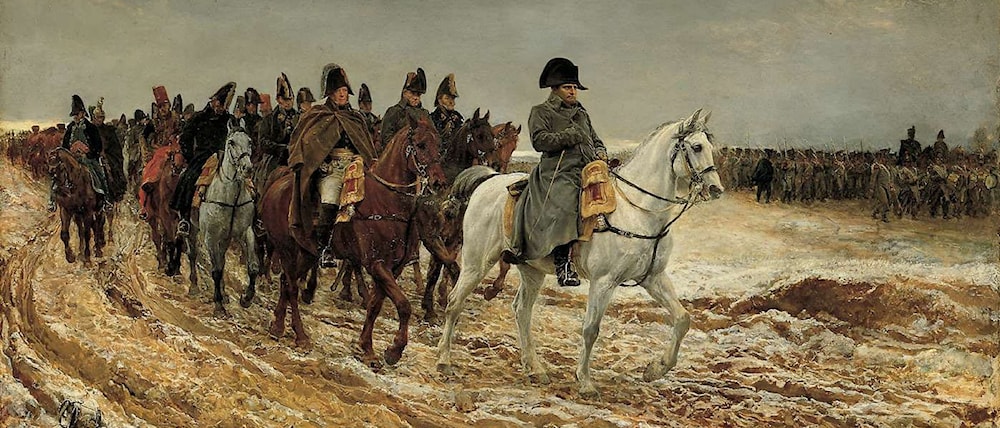Jean-Louis Ernest Meissonier
Jean-Louis Ernest Meissonier
157 artworks
French Romantic painter, sculptor, printmaker and colonel
Born 2/21/1815 - Died 1891

{"Id":84,"Name":"Jean-Louis Ernest Meissonier","Biography":"\u003Cp\u003E\u003Cstrong\u003EMEISSONIER, JEAN LOUIS ERNEST (1815\u0026mdash;1891)\u003C/strong\u003E, French painter, was born at Lyons on the 21st of February 1815. From his schooldays he showed a taste for painting, to which some early sketches, dated 1823, bear witness. After being placed with a druggist, he obtained leave from his parents to become an artist, and, owing to the recommendation of a painter named [Jules] Potier, himself a second class Prix de Rome, he was admitted to \u003Ca class=\u0022link\u0022 href=\u0022https://www.artrenewal.org/asp/database/art.asp?aid=1721\u0022 target=\u0022_blank\u0022\u003ELeon Cogniet\u0026rsquo;s\u003C/a\u003E studio. He paid short visits to Rome and to Switzerland, and exhibited in the Salon of 1831 a picture then called \u003Cu\u003ELes Bourgeois Flamands\u003C/u\u003E (\u003Cu\u003EDutch Burghers\u003C/u\u003E) but also known as \u003Cu\u003EThe Visit to the Burgomaster\u003C/u\u003E, subsequently purchased by Sir Richard Wallace, in whose collection (at Hertford House, London) it is, with fifteen other examples of this painter. It was the first attempt in France in the particular genre which was destined to make Meissonier famous microscopic painting\u0026mdash;miniature in oils. Working hard for daily bread at illustrations for the publishers \u0026mdash; Curmer, Hetze and Duboclier \u0026mdash; he also exhibited at the Salon of 1836 the \u003Cu\u003EChess Player\u003C/u\u003E and the \u003Cu\u003EErrand Boy\u003C/u\u003E. After some not very happy attempts at religious painting, he returned, under the influence of Chenavard, to the class of work he was born to excel in, and exhibited with much success the \u003Cu\u003EGame of Chess\u003C/u\u003E (1841), the \u003Cu\u003EYoung Man playing the Cello\u003C/u\u003E (1842), \u003Cu\u003EThe Painter in his Studio\u003C/u\u003E (1843), \u003Cu\u003EThe Guard Room\u003C/u\u003E, the \u003Cu\u003EYoung Man looking at Drawings\u003C/u\u003E, the \u003Cu\u003EGame of Piquet\u003C/u\u003E (1845), and the \u003Cu\u003EGame of Bowls\u003C/u\u003E \u0026mdash; works which show the finish and certainty of his technique, and assured his success. After his \u003Cu\u003ESoldiers\u003C/u\u003E (1848) he began \u003Cu\u003EA Day in June\u003C/u\u003E, which was never finished, and exhibited \u003Cu\u003EA Smoker\u003C/u\u003E (1849) and \u003Cu\u003EBravos\u003C/u\u003E (\u003Cu\u003ELes Bravi\u003C/u\u003E, 5852). In 1855 he touched the highest mark of his achievement with \u003Cu\u003EThe Gamblers\u003C/u\u003E and \u003Cu\u003EThe Quarrel\u003C/u\u003E (\u003Cu\u003ELa Rixe\u003C/u\u003E), which was presented by Napoleon III, to the English Court. His triumph was sustained at the Salon of 1857, when he exhibited nine pictures, and drawings; among them the \u003Cu\u003EYoung Man of the Time of the Regency\u003C/u\u003E, \u003Cu\u003EThe Painter\u003C/u\u003E, \u003Cu\u003EThe Shoeing Smith\u003C/u\u003E, \u003Cu\u003EThe Musician\u003C/u\u003E, and \u003Cu\u003EA Reading at Diderot\u0026rsquo;s\u003C/u\u003E. To the Salon of 1861 he sent \u003Cu\u003EThe Emperor at Solferino\u003C/u\u003E, \u003Cu\u003EA Shoeing Smith\u003C/u\u003E, \u003Cu\u003EA Musician\u003C/u\u003E, \u003Cu\u003EA Painter\u003C/u\u003E, and \u003Cu\u003EM. Louis Fould\u003C/u\u003E; to that of 1864 another version of \u003Cu\u003EThe Emperor at Solferino\u003C/u\u003E, and \u003Cu\u003E1814\u003C/u\u003E. He subsequently exhibited \u003Cu\u003EA Gamblers\u0026rsquo; Quarrel\u003C/u\u003E (1865), and \u003Cu\u003EDesaix and the Army of the Rhine\u003C/u\u003E (1867).Meissonier worked with elaborate care and a scrupulous observation of nature. Some of his works, as for instance his \u003Cu\u003E1807\u003C/u\u003E, remained ten years in course of execution. To the great Exhibition of 1878 he contributed sixteen pictures: the portrait of Alexandre Dumas which had been seen at the Salon of 1877, \u003Cu\u003ECuirassiers of 1805\u003C/u\u003E, \u003Cu\u003EA Venetian Painter\u003C/u\u003E, \u003Cu\u003EMoreau and his Staff before Hobenlinden\u003C/u\u003E, a \u003Cu\u003EPortrait of a Lady\u003C/u\u003E the \u003Cu\u003ERoad to La Salice\u003C/u\u003E, \u003Cu\u003EThe Two Friends\u003C/u\u003E, \u003Cu\u003EThe Outpost of the Grand Guard\u003C/u\u003E, \u003Cu\u003EA Scout\u003C/u\u003E, and \u003Cu\u003EDictating his Memoirs\u003C/u\u003E. Thenceforward he exhibited less in the Salons, and sent his work to smaller exhibitions. Being chosen president of the Great National Exhibition in 1883, he was represented there by such works as \u003Cu\u003EThe Pioneer\u003C/u\u003E, \u003Cu\u003EThe Army of the Rhine\u003C/u\u003E, \u003Cu\u003EThe Arrival of the Guests\u003C/u\u003E, and \u003Cu\u003ESaint Mark\u003C/u\u003E. On the 24th of May 1884 an exhibition was opened at the Petit Gallery of Meissonier\u0026rsquo;s collected works, including 146 examples. As president of the jury on painting at the Exhibition of 1889 he contributed some new pictures. In the following year the New Salon was formed (the National Society of Fine Arts), and Meissonier was-president. He exhibited there in 1890 his picture \u003Cu\u003E1807\u003C/u\u003E; a1so in 1891, shortly after his death, his \u003Cu\u003EBarricade\u003C/u\u003E was displayed there. A less well-known class of work than his painting is a series of etchings: \u003Cu\u003EThe Last Supper\u003C/u\u003E, \u003Cu\u003EThe Skill of Vuillaume the Lute Player\u003C/u\u003E, \u003Cu\u003EThe Little Smoker\u003C/u\u003E, \u003Cu\u003EThe Old Smoker\u003C/u\u003E, the \u003Cu\u003EPreparations for a Duel\u003C/u\u003E, \u003Cu\u003EAnglers\u003C/u\u003E, \u003Cu\u003ETroopers\u003C/u\u003E,\u0026rsquo; \u003Cu\u003EThe Reporting Sergeant\u003C/u\u003E, and \u003Cu\u003EPolichinelle\u003C/u\u003E, in the Hertford House collection. He also tried lithography, but the prints are now scarcely to be found.\u003Cbr /\u003E\u003Cbr /\u003EOf all the painters of the century. Meissonier was one of the most fortunate in the matter of payments. His \u003Cu\u003ECuirassiers\u003C/u\u003E, now in the late duc d\u0026rsquo;Aumale\u0026rsquo;s collection at Chantilly, was bought from the artist for \u0026pound;10,000 sold at Brussels for \u0026pound;11,000, and finally resold for \u0026pound;16,000 Besides his genre portraits, he painted some others: those of \u003Cu\u003EDoctor Lefevre\u003C/u\u003E, of \u003Cu\u003EChenavard\u003C/u\u003E, of \u003Cu\u003EVanderbilt\u003C/u\u003E,\u0026rsquo; of \u003Cu\u003EDoctor Guyon\u003C/u\u003E, and of \u003Cu\u003EStanford\u003C/u\u003E. He also collaborated with the painter Francais in a picture of \u003Cu\u003EThe Park at St Cloud\u003C/u\u003E.\u003Cbr /\u003E\u003Cbr /\u003EIn 1838 Meissonier married the sister of M. Steinbeil, a painter. Meissonier was attached by Napoleon III to the imperial staff, and accompanied him during the campaign in Italy and at the beginning of the war in 1870. During the siege of Paris in 1871 he was colonel of a marching regiment. In 1840 he was awarded a third-class medal, a second-class medal in 1841 first-class medals in 1843 and 1844 and medals of honour at the great exhibitions. In 1846 he was appointed knight of the Legion of Honour and promoted to the higher grades in 1856, 1867 (June 29), and 1880 (July 12), receiving the Grand Cross in 1889 (Oct. 29). He nevertheless cherished certain ambitions which remained unfulfilled. He hoped to become a professor at the \u0026Eacute;cole des Beaux Art, but the appointment he desired was never given to him. [...]\u003Cbr /\u003E\u003Cbr /\u003E\u003Cstrong\u003E\u003Cu\u003ESource:\u003C/u\u003E\u003C/strong\u003E Entry on the artist in the \u003Ca href=\u0022http://94.1911encyclopedia.org/M/ME/MEISSONIER_JEAN_LOUIS_ERNEST.htm\u0022 target=\u0022_blank\u0022\u003E1911 Edition Encyclopedia\u003C/a\u003E.\u003C/p\u003E\r\n\u003Cp\u003E\u0026nbsp;\u003C/p\u003E","BiographicalImageUrl":null,"StartYear":1815,"EndYear":1891,"Awards":null,"HasAlbums":false,"HasPortraits":true,"HasRelationships":true,"HasArticles":false,"HasDepictedPlaces":true,"HasLetters":true,"HasLibraryItems":true,"HasProducts":true,"HasSignatures":false,"HasVideos":false,"HasMapLocations":true,"TotalArtworks":157}


